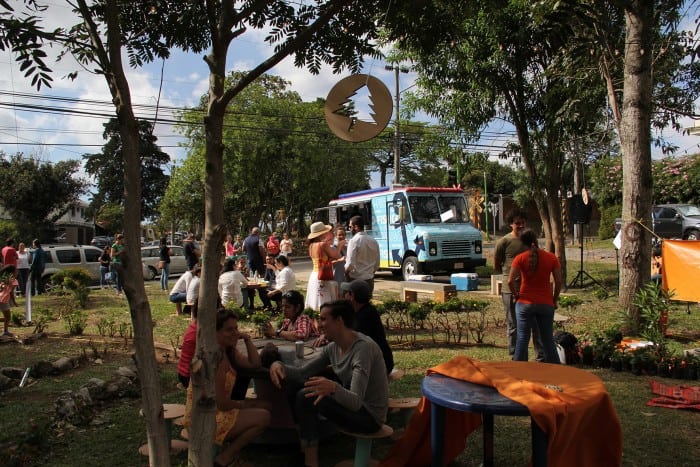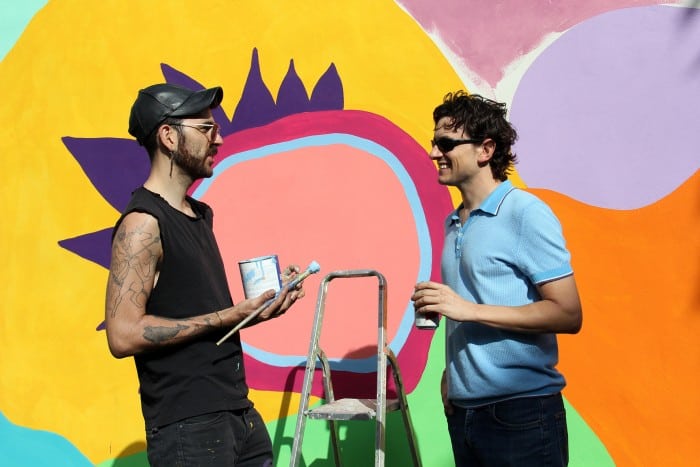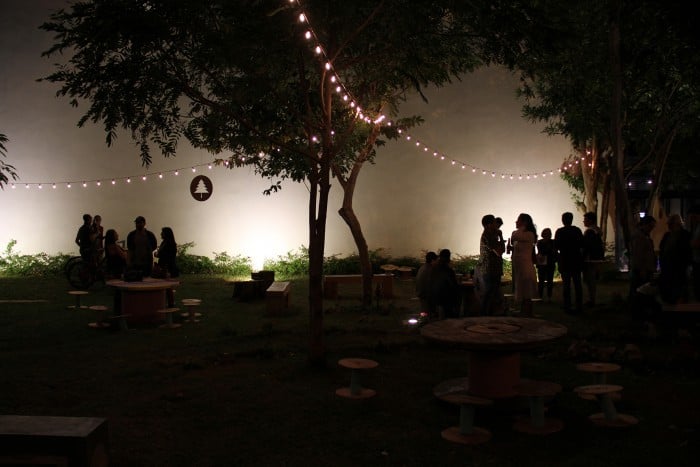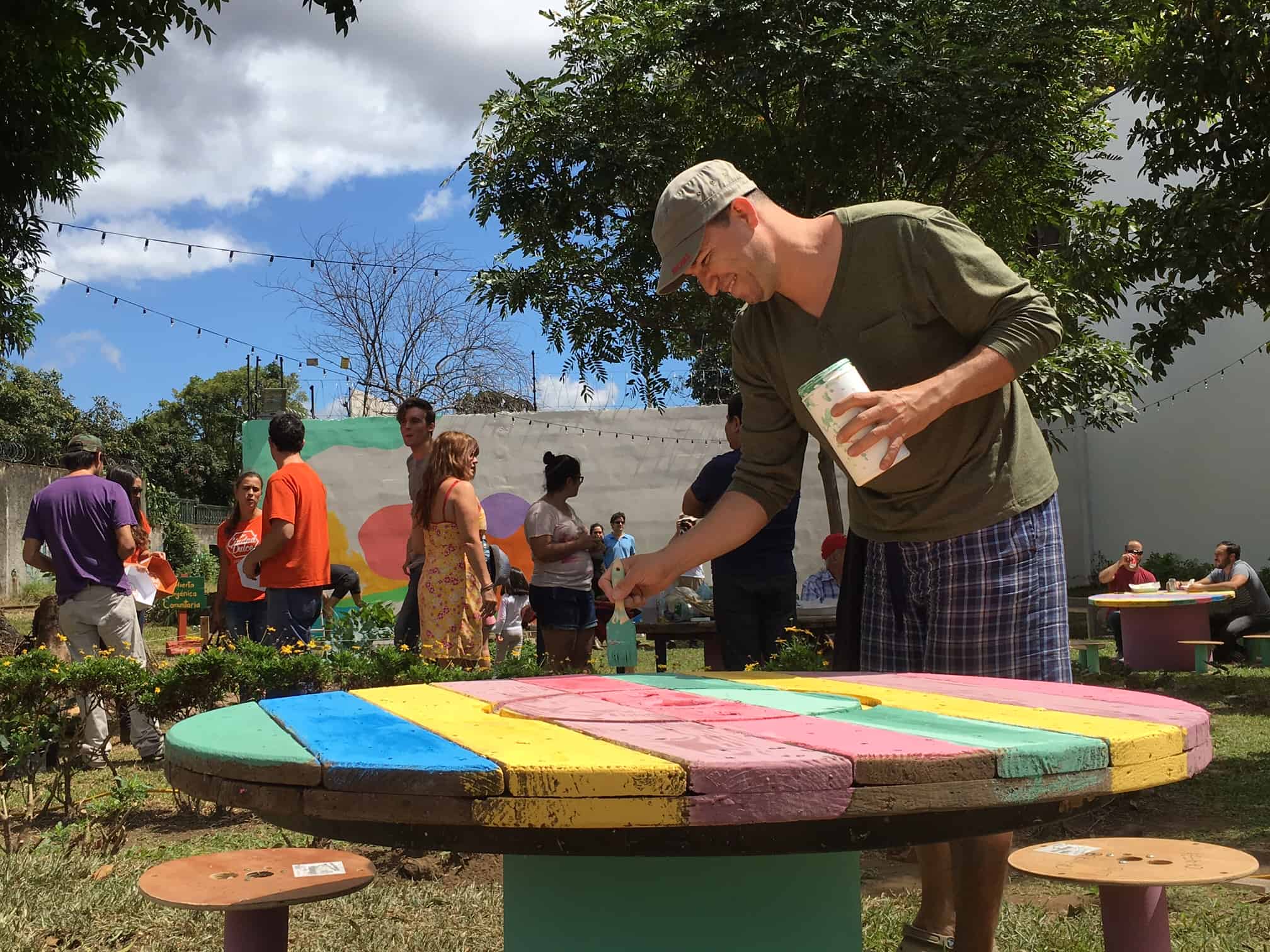“These days, our lives take place inside our houses,” said Franz González, wielding a paintbrush. “We’re trying to get people involved out here.”
González, a resident of the Freses neighborhood in the eastern Central Valley canton of Curridabat, was decorating a table at the inauguration of a new park featuring an organic garden, colorful mural and recycled electrical-wire spools used as stools. Around him, his neighbors and other visitors were chatting, listening to live music and lining up at a San José novelty: The park includes space for a food truck, which on inauguration day belonged to the popular Guayabos eatery Go Fish but will rotate among various restaurants in the future.
The Feb. 20 event seemed at first glance like a pretty typical, if particularly vibrant, neighborhood get-together. However, a closer look and a chat with the organizers revealed that months of planning, a wide range of stakeholders, and ambitious, innovative visions of city life were all at play in the small space, bordered on one side by train tracks and on the other by the Scott Pearl Izumi Reference Center, a bike shop which sponsored the lighting and security for the park.
“We have a larger project, an umbrella of sorts, called Ciudad Dulce (Sweet City), whose goal is to bring conservation into the city,” Curridabat Mayor Edgar Mora explained as a guitarist crooned some Stone Temple Pilots in the background. “We want every private garden in Curridabat to be full of color, every street a biological corridor, every neighborhood an ecosystem. We’re reintroducing native species … and [seeking to attract] tropical bees, hummingbirds and butterflies.”
Mora, of the local Curridabat 21st Century Party, was re-elected as mayor during Costa Rica’s municipal elections on Feb. 7, and is now preparing for his third term in office. So soon after extensive, election-inspired discussion nationwide of more mundane details of municipal life – trash pickup, road maintenance, property taxes – it was almost disorienting to hear a mayor say he’s working to “see our city from a bees-eye view.” It’s all part of Curridabat’s ambitious city plan, which won the Best City Plan award from the U.S. nonprofit Congress for the New Urbanism (CNU) in 2014.
The mayor, who studied at Harvard University’s Kennedy School of Government through an Ash Fellowship in 2013-2014, said that implementing the plan and truly placing nature at the center of municipal life will require changes in everything from building materials to public infrastructure. This “will take a long time, but this is a community that’s ready to take on the challenge.”
An organization playing a key role in supporting the municipality’s goals is A-01, a sustainable development organization co-founded and led by Dutch anthropologist Marije van Lidth de Jeude and German architect Oliver Schütte. Recent projects in which they have been involved include the BicipubliCartago initiative and a recycling center on Isla Chira in the Gulf of Nicoya. In Curridabat, where van Lidth and Schütte reside, they run the Popular School of Urbanism (PSU), a pilot program that guides neighborhood leaders through the nuts and bolts of local development while introducing them to various theories of urbanism. The school is supported by the municipality and the Chicago-based Graham Foundation.
Van Lidth de Jeude explained that they start simple, walking around the neighborhood with its residents and hearing their concerns and hopes. They then help put together a plan to make it all happen, working closely with the municipality, area businesses, universities and other key players. A-01, in partnership with the mayor, has worked with two Curridabat neighborhoods thus far, and is already branching out into more of the canton’s barrios.
In Freses, their work with the Neighbors’ Association led directly to the park, which was designed and created by the residents themselves.
Schütte said he welcomes a shift towards services to the community and projects on a neighborhood scale instead of focusing only on large-scale urban development, and that the Freses park represents what a community can do for itself by getting a wide variety of organizations involved. He noted that the Freses project was almost too successful – at one point the neighborhood association planned a food-truck festival to launch the park, but the response on Facebook was so massive (to the tune of 5,000 “may attends”) that they chose to cancel that aspect of the event. The goal for the neighbors is a local, sustainable, manageable project that they feel comfortable with, he said.
Mayor Mora says the key to the change he hopes to see is “trusting in our people.”
“We know that in Curridabat people want to get involved, but they want to get involved by doing something real,” he said. “Not just going to meetings.”
To learn more about the Popular School of Urbanism, visit the A-01 Facebook page. For more on the Freses park, including upcoming events and food-truck plans, visit the neighborhood association’s Facebook page.









